Via ships “world’s smallest mainboard”
May 22, 2007 — by LinuxDevices Staff — from the LinuxDevices Archive — 10 views PC chipset and board-maker Via Technologies today announced availability of the “world's smallest mainboard” — the first shipping board based on its recently unveiled, incredibly small (100 x 72mm) “pico-ITX” motherboard format. The Epia PX10000G is “available now for developers… in limited limited quantities,” the company said.
PC chipset and board-maker Via Technologies today announced availability of the “world's smallest mainboard” — the first shipping board based on its recently unveiled, incredibly small (100 x 72mm) “pico-ITX” motherboard format. The Epia PX10000G is “available now for developers… in limited limited quantities,” the company said.
digg this story |
Via offered an early look at its pico-ITX design in January, at an event associated with the Consumer Electronics Show in Las Vegas. Then, in April, the company revealed further details of its VT6047 pico-ITX hardware reference design.

Via's Epia PX series mainboards measure 3.9 x 2.8 inches
(Click to enlarge)
At 3.9 x 2.8 inches (100 x 72mm), Via's pico-ITX motherboard form-factor represents “the smallest complete x86 mainboard in the industry,” Via claims. Pico-ITX format boards occupy half the surface area of nano-ITX boards, and a quarter that of boards based on the now 5-year-old mini-ITX standard. This miniaturization has been enabled in part by an 82 percent real estate reduction of Via's chipsets, which have shrunk from 50 x 50mm in mini-ITX's original “Socket 370” processors to just 21 x 21mm for the “nanoBGA” package used for Via's current-generation C7 processors.
Epia PX10000G
The Epia PX10000G board that Via is now shipping is based on a 1GHz Via C7 processor, and it provides an SO-DIMM socket for up to 1GB of DDR2 533 SDRAM memory. The 10-layer board also integrates Via's VX700 system media processor, which features Via's UniChrome Pro II IGP 3D/2D graphics core, MPEG-2/-4, and WMV9 hardware decoding acceleration. Via notes that the board's graphics engine can support the high resolutions required for displaying HD DVD playback.
Numerous input/output connections — mostly accessible by means of pin-header connectors, due to space restrictions — provide a broad set of standard PC I/O interfaces. These include 10/100 Mbps Ethernet, USB2.0, serial COM port, IDE, SATA, PS2 mouse/keyboard, audio, and video.
The board uses what Via calls a pico-ITX power connector. As far as power consumption is concerned, the board “can run standard productivity and multimedia applications at under 13W,” Via says.
Via lists the following key specifications for the Epia PX10000G board:
- Processor/chipset:
- Via C7 clocked at 1.0GHz (in NanoBGA2 package)
- Via VX700 Unified Digital Media IGP chipset
- Integrated VIA UniChrome Pro II 3D/2D AGP graphics with MPEG-2/4 and WMV9 decoding acceleration
- Via VT6106S 10/100Mbps Ethernet controller with power management functions
- Via VT1708A high definition audio codec
- Memory:
- DDR2 533 SODIMM socket for up to 1GB memory
- 4 or 8 Mbit soldered-on flash
- Drive interfaces:
- IDE — UltraDMA 133/100/66 connector (on 2.0mm 44-pin header)
- Serial ATA connector
- Onboard I/O Connectors:
- 4 x USB2.0 (pin headers)
- COM port connector
- PS2 mouse/keyboard (pin header)
- LVDS/DVI connector
- Multimedia connector — supports external TV-out interface, video capture port interface, and low-pin-count interface (requires an add-on card)
- Audio pin header — line-out, line-in, mic-in, S/PDIF in, and 7.1 channels audio output
- CPU fan (pin header)
- Pico-iTX power connector
- Back Panel I/O:
- RJ-45 LAN port
- VGA port
- System Monitoring & Management:
- CPU temperature reading (manufacturing option)
- Watch Dog Timer (manufacturing option)
- Keyboard-Power-on, Timer-Power-on
- Wake-on-LAN
- System power management
- AC power failure recovery
- Operating temperature — 0°C ~ 50°C
- Operating humidity — 0% ~ 95% (relative humidity; non-condensing)
- Form-factor — 3.9 x 2.8 inches (100 x 72 mm)
Enclosure design
Via has developed a reference design for a small enclosure that can be used to package the PX10000G and other members of Via's nascent Epia PX pico-ITX motherboard series.

Via's pico-ITX enclosure reference design
Availability
According to Via, the Epia PX10000G board is “available now for developers, and will be available in limited quantities through authorized distributors in late May.”
This article was originally published on LinuxDevices.com and has been donated to the open source community by QuinStreet Inc. Please visit LinuxToday.com for up-to-date news and articles about Linux and open source.